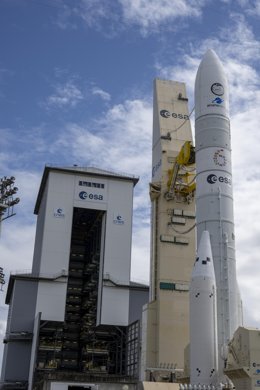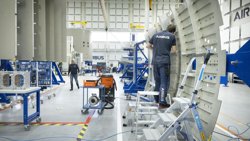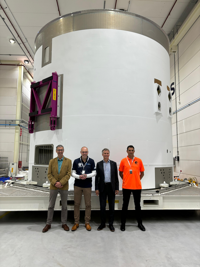Europe is restoring autonomous launch capacity with Ariane 6, and the Netherlands is supplying important components
The European Space Agency will launch the very first Ariane 6 rocket tonight between 8:00 PM and 12:00 AM Dutch time. After more than a year without its own launch capacity, Europe is restoring its guaranteed access to space. Dutch companies developed various parts for the Ariane 6, which they supply for every model launched in the co
ESA - L. Bourgeon
ming years.
The Ariane 6 rocket is capable of putting the world's heaviest satellites into orbit. It is considerably cheaper to launch than its predecessor Ariane 5. And thanks to innovative technology from the Netherlands, the rocket is also more versatile. So expectations are high: the Ariane 6 should become the new 'workhorse' for European satellite launches.
The inaugural launch of Ariane 6 is an important milestone and a boost for Europe. Because the smaller Vega rocket is currently on the ground with technical problems and the Ariane 5 is also unavailable, because it retired in July last year. The Ariane 6 should have been ready by then, but the development of the rocket was delayed due to technical setbacks and the corona pandemic.
Strategic importance
The fact that Europe can launch satellites autonomously again from tomorrow 'is of great strategic importance for our society, security, prosperity and for our knowledge of the earth and the universe', says NSO board member Joost Carpay. “Moreover, we are building this rocket in Europe, so the money we spend on launches benefits the European industry.”
The Netherlands also supplies parts for the new Ariane 6 rocket. Airbus Netherlands in Leiden is building the bottom of the rocket, the Vulcain Aft Bay. This component, which weighs almost five thousand kilos, must be able to withstand great forces and high temperatures. Airbus also supplies the engine frame for the second rocket stage, called Vinci Thrust Frame. This is a relatively small and light aluminum structure.
“We focus on complex structures,” says Frank Meiboom of Airbus Netherlands. 'They should be as light as possible, but still rigid. They are heavily loaded, very hot and they have to deal with intense vibrations.'
Airbus previously 
© Taco van der Eb
supplied similar parts for the Ariane 5 rocket, but was ordered to make them significantly cheaper for the Ariane 6. “We have spent years developing new production methods, simulation methods and even built a completely new factory in Oegstgeest with robotized production to achieve this,” says Meiboom.
Although the first launch of the Ariane 6 has yet to take place, Airbus Netherlands is already working on an improved version of the Vulcain Aft Bay, the bottom of the Ariane 6 rocket. From the sixteenth flight model onwards, the component becomes eight hundred kilos lighter. “Thanks to such a large mass reduction, you can launch more satellites with the same rocket,” says Meiboom. 'In this way we make the Ariane 6 increasingly efficient and better. This is necessary, because the market for launch rockets is very competitive.'
Innovative ignition
The other Dutch contribution to the Ariane 6 comes from the company Aerospace Propulsion Products from Klundert. APP supplies the igniters that start the engines of the Ariane 6 rocket. The igniter of the first rocket stage works like a rocket and ignites once. That of the second rocket stage works with liquid fuel and can be restarted up to four times.
f.l.t.r Joost Carpay (NSO), Edwin Vermeulen (APP), Frank Meiboom (Airbus Nederland) en Benoit Laine (ESA) at the production facility of Airbus in Oegstgeest.
The innovative igniter provides two major advantages, explains APP director Edwin Vermeulen. Thanks to the restartable igniter, the Ariane 6 rocket can deliver multiple satellites to different orbits in one flight. In addition, the second rocket stage can slow down and return to Earth to burn up in the atmosphere. This method minimizes the amount of space debris from the new European rocket.
More information
The launch of the very first Ariane 6 rocket will take place between eight and twelve o'clock in the evening Dutch time and can be followed live via ESA TV. More information can be found in the Ariane 6 overview on the ESA website.